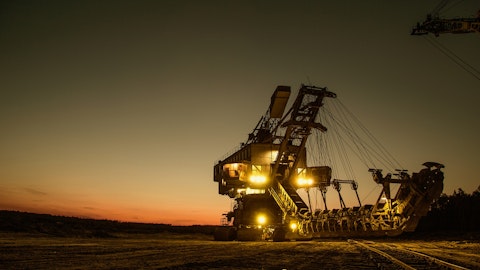Lorin Crenshaw: Yeah, we’re $100 below where we expect this business to be on a cash-cost basis. If you look back over the past five years, you multiply that times our tons when you get $30 million. These businesses ought to be in that in the range you just referred to. And that’s going to be a focus of our efforts in the coming years. From a long-term perspective, as we harvest less and less the ponds, just deposit and concentrate, we expect that we will get better yields over that two or three-year deposition process, but we’re not going to just wait for that. We’re also looking at the cost base at Ogden in terms of things we can do in the near term to improve the cost base as we wait for the ponds to regenerate.
David Begleiter: Very good. Thank you.
Operator: We will take our next question from Greg Lewis with BTIG. Your line is open.
Greg Lewis: Yeah, thank you and good morning and thanks for taking my questions. My first one was, I did want to go back on costs. So, as we think about freight, it seems like that could be pulling on that a little bit. Anyway to kind of gauge how much of your freight costs are fixed or is it, they are when we could see like those agreements, like I guess re-contract or reset?
Kevin Crutchfield: Hey, Greg. We — you were garbled up there. Could you please repeat your question for us?
Greg Lewis: It was around freight costs and really [Technical Difficulty] if we were to see freight costs generally across North America moved lower, like how should we think about the company benefiting from that impact, i.e., as you look at your freight exposure, how much of its kind of a spot contract [Technical Difficulty] is my question, the first one.
Jamie Standen: Sure. Greg, this is Jamie. So, we’ve assumed we talked about it in different buckets. On the vessel and barge side for 2024, we’re going to see typical inflationary pressure, a lot of those are fixed. When we look at truck for 2024, we think the truck market is actually bottoming out now, maybe first quarter, and would be expected to rise. Given the some of the freight supply rationalization, Conway, Yellow bankruptcies, so we think the supply picture of freight is shrinking actually. And with the post-pandemic destocking behind us, we think there’s demand increase in retail over the next year. So, we’ve baked into our plan, and for 2024 increased truck rates really in the back half of the year. Now that is significant. It is a significant increase. Think of it as 15% or so. But if that does not occur and the bottom stays in longer and freight rates don’t rise, we would stand to benefit from that versus our current operating plan.
Greg Lewis: Okay, perfect. Super helpful. And then, I did want to realizing that we need to kind of move forward in the project, but when we think about a strategic partner, you mentioned on the lithium side, I mean really with the project and largely funded at least Phase 1, like when we think about a strategic partner, is that just really an offtake partner, is that kind of a fair way to think about it or any kind of rough how you’re thinking about like what you’re looking for in terms of that partner? And really just given what’s the ongoing, I don’t know landscape in Utah, is that something where we probably won’t see that partner until we kind of get more clarity and can move forward, and though we have a better line of sight on when we could see I guess the lithium project move forward?
Kevin Crutchfield: Yeah. So, I think in terms of conditions precedent to having a partner, it would have to be regulatory legislative clarity in Utah, where you’ve got a horizon that is suitable for long — making long-term investments. So clearly, as I mentioned earlier, when David asked his question, there is work there to be done. And then secondarily, we still have — we still want to prove out the DustGard unit to demonstrate to the world that, that is a scalable technology at commercial level. So anything that we would do with a partner would be conditioned upon those two criteria having been met. And then in terms of the type of the partner where we’d be looking for, I mean, clearly a balance sheet, reduce our capital exposure at the project level and then ideally, it would be nice to have a partner that’s got some sort of prowess in that domain space, lithium or the EV world itself. So that gives you kind of some sense of how we’re thinking about it.
Greg Lewis: Okay, super helpful. Thank you, very much.
Kevin Crutchfield: Yep, thank you.
Operator: [Operator Instructions] And we will take our next question from Vincent Anderson with Stifel. Your line is open.
Vincent Anderson: Yeah, thanks, good morning. Going back to the drivers of Salt margin expectations, I mean you hit on the variable components, super helpful, but I was hoping you could maybe frame the season-on-season changes in fixed cost leverage. And then any incremental net back positive — positives or negatives based on the geographical mix of your commitments this year versus last year.




